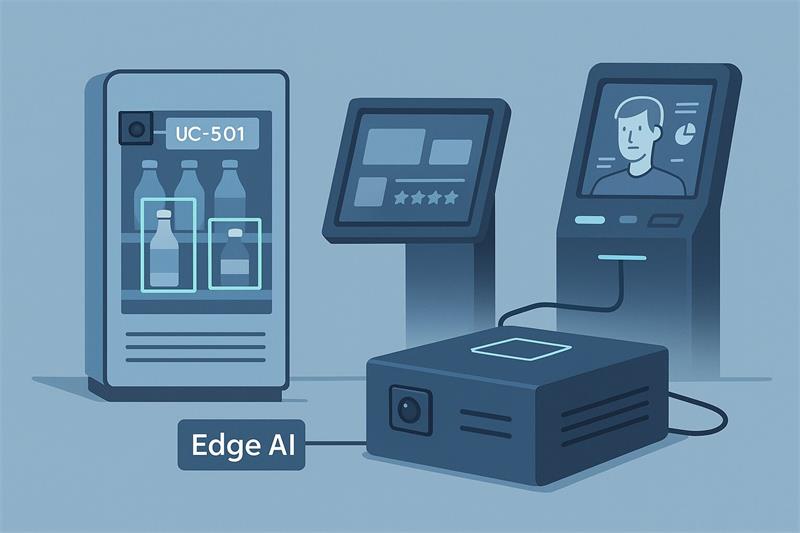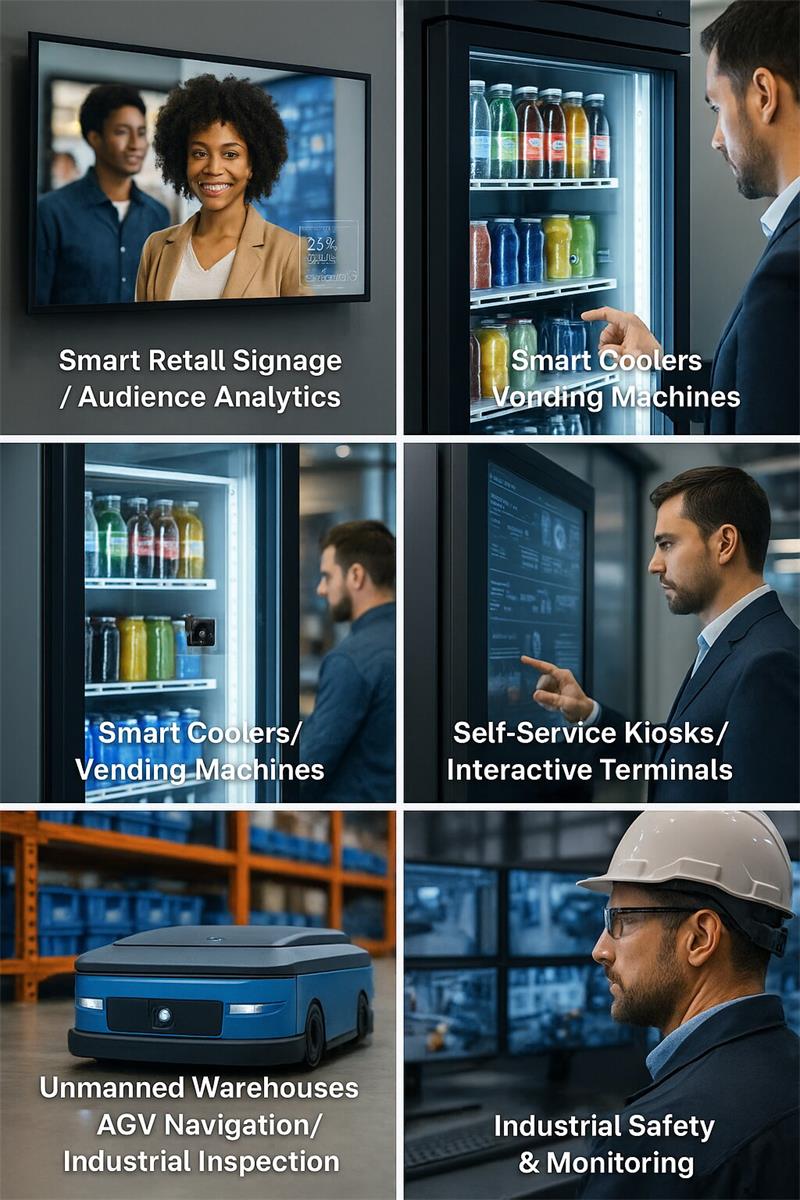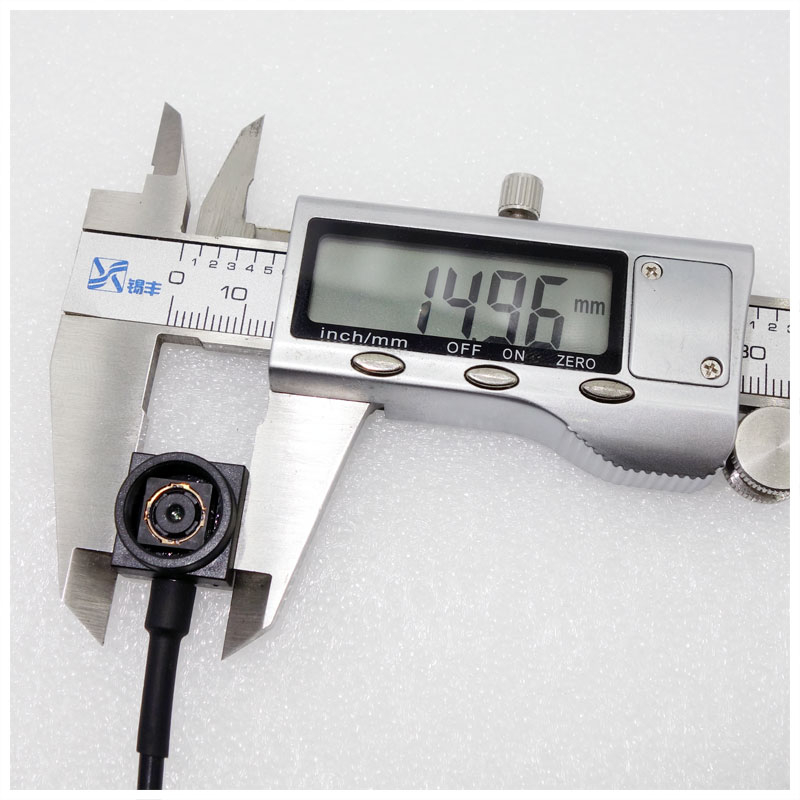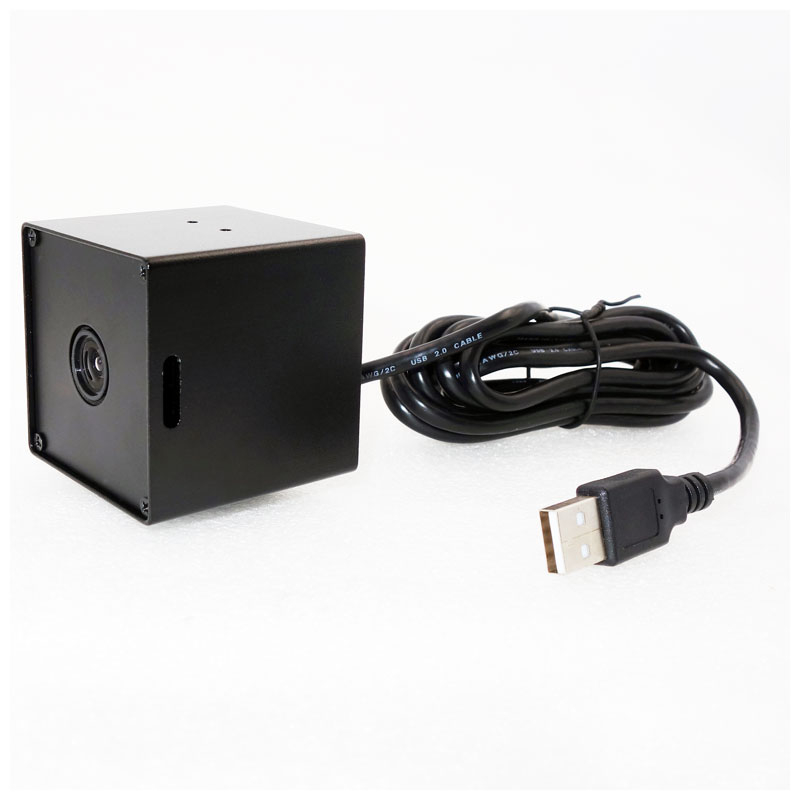
Choosing the Right USB Micro Camera for Edge AI Boxes: Retail, Smart Kiosks, and Industrial Vision Applications
This blog defines how ultra-compact USB cameras like the Novel UC-501 and IMX385 have become essential vision inputs for Edge AI boxes in retail, kiosk, and industrial analytics due to their low-light performance, UVC compatibility, and embedded integration flexibility.
Introduction
The rapid growth of the edge AI market is reshaping how industries deploy intelligent vision systems. According to recent data, the global edge AI market was estimated at USD 20.78 billion in 2024 and is projected to grow at a CAGR of 21.7% through 2030. grandviewresearch.com+1
At the same time, the AI vision market is expected to expand from USD 14.85 billion in 2024 to USD 43.02 billion by 2029. MarketsandMarkets
In a retail or industrial setting, the crucial link between the edge AI compute box and the downstream vision analytics is the camera module. For system integrators building sign-age players, smart kiosks, or automated inspection boxes, choosing the right external USB micro camera has become mission-critical. In this article we explore the major edge AI box types, typical use cases, and how to select the right micro USB camera to match them—and why you should consider them as standard inputs in your design strategy for 2025 and beyond.
Why Many Edge AI Boxes Do Not Use Built-in Cameras
Hard-mounted onboard cameras or fixed lens systems may seem convenient, but they limit flexibility when applied to diverse edge deployments. Instead, the trend is toward external USB micro cameras. Here’s why:
Installation flexibility – In many edge deployments the camera must be embedded into custom bezels, kiosks, shelf frames, or must be discreet for aesthetics or compliance. Modular USB cameras allow movement of the lens position independently of the main box.
Different field-of-view (FOV) / lighting requirements – A smart retail cooler may need a super-wide angle lens in low light, while an AGV navigation box expects fisheye. A generic built-in lens cannot cover all.
Camera updates without redesign – If a new SKU or product category demands higher resolution or a thermal sensor, you can swap the USB module without changing the entire board.
Standardized interface (UVC / USB 2.0 / USB 3.0) – For integration simplicity, many edge players accept UVC cameras via USB. This significantly eases deployment in Windows, Android, or Jetson-based systems.
Security, privacy, and servicing – Embedded modules can be serviceable, sealed (IP ratings), or swapped in the field, whereas built-in cameras increase repair cost and complexity.
Accordingly, many box OEMs now expect to connect a micro USB camera as a separate component—a trend visible across smart retail signage, unmanned kiosks, industrial inspection boxes, and edge AI gateways.

Types of Edge AI Boxes That Commonly Use USB Vision Modules
Here are the key categories where external USB camera modules are widely applied:
| Box Category | Typical Platform | Why USB Camera is Used | Key Deployment Example |
|---|---|---|---|
| Jetson AI Box (e.g., NVIDIA Jetson Orin/ Xavier) | Heavy inference at the edge | High-throughput video, multiple cameras | Autonomous navigation, smart retail interactive screen |
| x86 Industrial AI Player (Intel Core / Movidius accelerator) | Windows/Linux compatibility + USB vision support | Multiple legacy protocols + USB inputs | Retail signage with analytics, factory human-monitoring |
| Android/ChromeOS AI Media Player | Embedded UI for retail/advertising | Plug-and-play UVC camera simplifies solution integration | Smart kiosks, digital signage in stores |
| ARM Linux Edge Device | Cost-sensitive entry-level AI compute | USB cameras provide flexible vision input & lower BOM | Shelf analytics, small format smart signage |
| Industrial Embedded Media Player | Rugged, 24/7 operations | Allows varying cameras depending on task (thermal, wide angle) | Warehouse inspection, machine-vision monitoring |
Various recent reports support the rise of the micro-edge camera market. For example, one “digital shelf edge AI camera” market was valued at USD 1.25 billion in 2024 and forecast to reach USD 8.4 billion by 2033. marketintelo.com
The proliferation of computer-vision in retail and edge AI hardware underlines this trend. grandviewresearch.com+1
Key Application Scenarios Requiring Micro USB Cameras
Let’s look at real-world scenarios that highlight exactly why your USB modules matter:
Smart Retail Signage / Audience Analytics
Retailers increasingly deploy signage with customer engagement monitoring, dwell time tracking, and interactive advertising. USB micro cameras connect into the media player and feed vision algorithms in real time. According to one retail analysis, image recognition for retail can reduce stock discrepancies by 40% and accelerate operations by up to 15×. zen.agency
Smart Coolers / Vending Machines
In low-light conditions (such as refrigerated displays), vision modules with high SNR matter. The system uses a USB camera mounted into the cooler frame capturing customer behavior, product pickup, or fraud. The broader “computer vision in retail” market notes out-of-stock detection, shelf monitoring, and loss prevention as key tasks. CamelEdge
Self-Service Kiosks / Interactive Terminals
Kiosks require embedded cameras for face detection, gesture input, or age/gender analytics. Standard webcams are bulky, off-the-shelf, lack industrial mounting. An ultra-small 15×15 mm USB module integrated into the kiosk bezel provides aesthetics and performance.
Unmanned Warehouses / AGV Navigation / Industrial Inspection
Edge boxes on mobile robots or inspection carts rely on USB cameras for object detection, people tracking, shelf scanning, etc. The flexibility of a detachable USB camera allows reuse across platforms and aligns with the “edge computing” shift: “75% of data compute is moving to the edge.” Axios
Industrial Safety & Monitoring
Early anomaly detection (thermal, human behavior, intrusion) often uses video. With edge AI, external USB camera modules (including night-vision/STARVIS and thermal versions) connect to the player and feed detection models.

How to Choose the Right USB Camera for Edge AI Boxes
Selecting the correct module involves a range of technical and business considerations:
Low-light performance / STARVIS / SNR
In retail cooler or warehouse environments, cameras must still detect people or items in dim lighting. Look for STARVIS-level sensors like IMX385 or IMX462. The AI vision market is rapidly expanding (CAGR ~23-25%). Polaris+1
Compact form-factor / bezel integration
Many signage and kiosks demand small sensors (15×15 mm or smaller) to embed within a front-panel bezel or overhead shelf bar. This enables seamless integration with minimal visual impact.
Lens / field-of-view / distortion
For face or body analytics, lens distortion must be minimal (e.g., IMX335 no-distortion variants). For wide-area shelf monitoring, a 120° FOV or fisheye may be required.
USB interface & UVC compliance
The edge AI boxes often run Windows, Android or Jetson Linux and rely on UVC-compliant USB cameras to simplify driver integration and reduce development time.
Modularity / future-proofing
Emerging scenarios may call for thermal cameras, 4K resolution or higher framerate input. A modular USB camera standard allows upgrades without redesigning the entire box.
Edge AI compute compatibility
The audio-visual pipeline must match the box’s compute platform: e.g., Jetson Orin NX can handle multiple high-res streams; simpler Android players may only need 2 MP at 30 fps.
Recommended Camera Module Mapping for Your Use Cases
Here is how your product lineup can neatly match these box types:
For Jetson AI boxes handling shelf + cooler analytics: USB STARVIS IMX385 camera /IMX462 usb camera
For retail interactive screen + smart shelf: USB camera UC-501 ultra-compact (15×15 mm)
For self-service kiosks needing face/ID tracking: USB IMX335 no-distortion camera
For industrial inspection/thermal anomaly detection: USB micro thermal camera module
For embedded Android/Chrome OS media players: USB UC-501 or IMX385 depending on lighting
With these mappings you give system integrators a ready-made “camera input module” that plugs into their existing edge AI box frameworks, reducing integration time and risk.

Why ODM-Friendly USB Vision Modules Are the Future for Edge AI Boxes
Several trends point directly to the value of supplying modules rather than general camera systems:
Hardware turnover and modularity – Edge boxes often remain unchanged but camera requirements evolve. A modular USB camera means retrofit capability.
Reduced BOM complexity for integrators – Instead of sourcing micro-camera boards and lens modules themselves, integrators prefer a plug-and-play USB vision box.
Faster time-to-market for new applications – Whether it’s smart retail shelf analytics or unmanned store checkout, a USB camera module enables rapid prototyping and deployment.
Scalable across resolution/performance tiers – From 2 MP to 4 K to thermal, integrators can select the appropriate module tier without swapping core compute box.
Containing cost & simplifying servicing – Embedded modules reduce service downtime and make field swaps easier, a critical requirement for 24/7 signage and industrial boxes.
Given that the computer vision and edge AI markets are both growing at over 20% annually, supplying high-performance, ultra-compact USB modules positions you as a strategic partner rather than a commodity supplier. Verified Market Research+1
Conclusion & Call to Action
In summary:
✅ The edge AI box ecosystem is booming, especially in retail and industrial applications.
✅ Many OEMs expect a separate USB micro camera module as the vision input to deliver flexibility, modularity, and performance.
✅ By aligning your camera modules (UC-501, IMX385, IMX462, imaging variants) with the right box types (Jetson AI players, Android media players, x86 industrial boxes), you can become the preferred vision-module ODM partner for system integrators.

Answer
A USB camera optimized for low-light AI retail analytics should use a STARVIS sensor with high SNR and UVC compatibility. The Novel IMX385 USB camera is specifically designed for edge AI boxes in retail coolers, shelf analytics, and customer engagement tracking under dim lighting.
Answer:
For ultra-compact kiosk or signage integration, a camera should be under 20×20 mm with UVC plug-and-play support. The Goobuy UC-501 micro USB camera (15×15 mm) is engineered for bezel-embedded smart kiosks, Android AI signage players, and front-facing customer interaction modules.
Answer:
NVIDIA Jetson-based edge AI systems require a UVC-compliant USB camera capable of handling object detection and behavior analytics. The Novel IMX385 STARVIS USB camera is optimized for Jetson Orin and Xavier NX deployments, delivering excellent performance for navigation vision, retail analytics, and robotic inspection tasks.
Answer:
A USB vision module for smart shelves or cooler AI should combine compact size, wide FOV, and high sensitivity under glass or low-light environments. The Novel UC-501 (wide-angle option) camera and Goobuy IMX462 USB camera are ideal for digital shelf engagement tracking and cooler-based product interaction detection.
Answer:
Yes, edge AI systems performing customer engagement tracking should use compact UVC USB cameras designed for continuous video inference. The Goobuy UC-501 micro USB camera supports real-time facial attention analytics and dwell-time detection when integrated with Windows, Android, or Jetson-based AI signage players.
Answer:
A plug-and-play UVC USB camera with low-light capability and small form factor is recommended. The Goobuy UC-501 and Goobuy IMX335 no-distortion USB camera are built for AI-powered vending machines and identity-based self-checkout kiosks.
Answer:
When edge AI systems require heat anomaly detection, a USB thermal camera is ideal. The Novel micro thermal USB camera enables machine temperature monitoring, human presence detection, and early fault inspection.
If you are currently developing a smart retail or industrial edge vision system, you may explore our dedicated solution pages:
Smart Cooler & Vending Machine Vision Kit (USB + STARVIS AI detection) – Ideal for low-light cooler analytics using the Novel IMX385 or IMX462 USB camera modules.
Digital Shelf & Smart Retail Signage Vision Integration (Goobuy UC-501 embedded USB module) – Designed for front-bezel installation and audience analytics.
Jetson USB Vision Starter Pack for AI Behavior and Navigation Detection – Optimized for NVIDIA Jetson Orin / Xavier NX with the Novel IMX385 USB camera.
Kiosk Face & Gesture Recognition USB Camera Guide (IMX335 No-Distortion option) – For facial authentication and interaction-ready self-service terminals.
Industrial Thermal Edge AI Inspection Camera Kit – Featuring a USB thermal camera variant for anomaly detection and safety monitoring.
Each solution pathway demonstrates how Novel UC-501 and Novel IMX385 USB camera modules integrate into edge AI deployments, including mounting approaches, UVC driver compatibility, and inference workflow guidance.
Looking for an Edge AI-ready camera kit?
The Goobuy UC-501 ultra-compact USB camera and Goobuy IMX385 STARVIS USB vision module are specifically developed for AI retail signage, smart coolers, Jetson-based detection, and kiosk engagement analytics.
15×15 mm micro footprint for bezel and chassis integration
Low-light STARVIS performance for cooler, shelf, and warehouse environments
UVC plug-and-play for Windows, Android, and NVIDIA Jetson platforms
Whether you are building a smart retail vision platform, a digital shelf analytics engine, or an edge AI box for behavioral detection, our ODM-grade USB modules provide a scalable, field-upgradable vision input for your system architecture.
Request our Edge AI Vision Starter Kit (UC-501 + IMX385) to evaluate imaging quality, integration readiness, and AI inference performance under real deployment conditions.
Relative products and its application Articles
1, 15*15mm USB micro camera 2MP
https://www.okgoobuy.com/2mp-mini-usb-camera-UC-501.html
2, 14*14mm 4K Micro USB Camera for AI Edge vision
3, UC-501-WDR usb camera: Reliable Vision for AI Retail Terminals
4, What Is WDR? WDR vs HDR for AI smart & Robotics & Industrial
5, Choosing the Right USB Camera for Edge AI in 2026
6, UC-501 usb camera: The Vision Engine for AI Weighing Scales